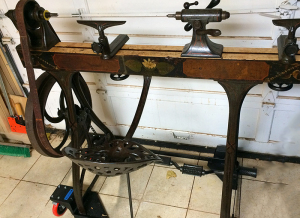RWW 188 Barnes No 3 Lathe
 Well I added another lathe. I admit it, I have a problem. The last thing I needed was another treadle driven lathe, but I long told myself that if I ever got the chance to own a Barnes lathe I would do it. And so I did. I’ve been turning on this lathe for more than 5 years when I have been volunteering at the Steppingstone Museum. It is a thing of beauty and I view it as the pinnacle of the foot powered continuous motion lathes. “Powered” lathes were already in use when these Barnes models hit the market, but this was targeted at small shops and rural users where steam power was not an option. Essentially this lathe was the last stop in the evolution before motors became standard equipment and thus I believe it to be the most refined design. It was only natural that despite the lathes I had already built, the Barnes would take a place of honor in my shop.
Well I added another lathe. I admit it, I have a problem. The last thing I needed was another treadle driven lathe, but I long told myself that if I ever got the chance to own a Barnes lathe I would do it. And so I did. I’ve been turning on this lathe for more than 5 years when I have been volunteering at the Steppingstone Museum. It is a thing of beauty and I view it as the pinnacle of the foot powered continuous motion lathes. “Powered” lathes were already in use when these Barnes models hit the market, but this was targeted at small shops and rural users where steam power was not an option. Essentially this lathe was the last stop in the evolution before motors became standard equipment and thus I believe it to be the most refined design. It was only natural that despite the lathes I had already built, the Barnes would take a place of honor in my shop.
This video details how it goes together, what I did to restore it to beauty, and my initial turning on it.
Improvements To Do List
There is still a gap between my experience working on the museum lathe and my own, and in the coming months I’m going to see if I can meet and exceed that performance mark.
- First I need to shore up the base to stop the movement. I’m going to start by building a rigid frame that the lathe will sit on and be captured inside the mobile base frame. This should stop the shimmy action. If that fails I may have to ditch the mobile base idea. I’m open to other suggestions.
- Add an adapter so I can use the current threaded accessories like my chucks with 1×8 tpi threads.
- Build a dedicated turning stool that incorporates the original tractor style seat. As cool as the integral seat it, I’m just too tall for it.
- Incorporate some dust collection. I think I can reverse the seat arm and use it to attach a dust port.
- Install a disco ball


